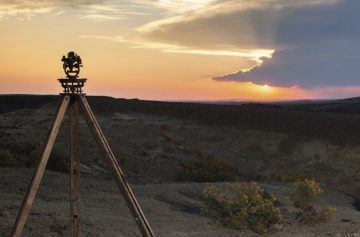Douglas Preston in The New Yorker:
 If, on a certain evening about sixty-six million years ago, you had stood somewhere in North America and looked up at the sky, you would have soon made out what appeared to be a star. If you watched for an hour or two, the star would have seemed to grow in brightness, although it barely moved. That’s because it was not a star but an asteroid, and it was headed directly for Earth at about forty-five thousand miles an hour. Sixty hours later, the asteroid hit. The air in front was compressed and violently heated, and it blasted a hole through the atmosphere, generating a supersonic shock wave. The asteroid struck a shallow sea where the Yucatán peninsula is today. In that moment, the Cretaceous period ended and the Paleogene period began.
If, on a certain evening about sixty-six million years ago, you had stood somewhere in North America and looked up at the sky, you would have soon made out what appeared to be a star. If you watched for an hour or two, the star would have seemed to grow in brightness, although it barely moved. That’s because it was not a star but an asteroid, and it was headed directly for Earth at about forty-five thousand miles an hour. Sixty hours later, the asteroid hit. The air in front was compressed and violently heated, and it blasted a hole through the atmosphere, generating a supersonic shock wave. The asteroid struck a shallow sea where the Yucatán peninsula is today. In that moment, the Cretaceous period ended and the Paleogene period began.
A few years ago, scientists at Los Alamos National Laboratory used what was then one of the world’s most powerful computers, the so-called Q Machine, to model the effects of the impact. The result was a slow-motion, second-by-second false-color video of the event. Within two minutes of slamming into Earth, the asteroid, which was at least six miles wide, had gouged a crater about eighteen miles deep and lofted twenty-five trillion metric tons of debris into the atmosphere. Picture the splash of a pebble falling into pond water, but on a planetary scale. When Earth’s crust rebounded, a peak higher than Mt. Everest briefly rose up. The energy released was more than that of a billion Hiroshima bombs, but the blast looked nothing like a nuclear explosion, with its signature mushroom cloud. Instead, the initial blowout formed a “rooster tail,” a gigantic jet of molten material, which exited the atmosphere, some of it fanning out over North America. Much of the material was several times hotter than the surface of the sun, and it set fire to everything within a thousand miles. In addition, an inverted cone of liquefied, superheated rock rose, spread outward as countless red-hot blobs of glass, called tektites, and blanketed the Western Hemisphere.
More here.
